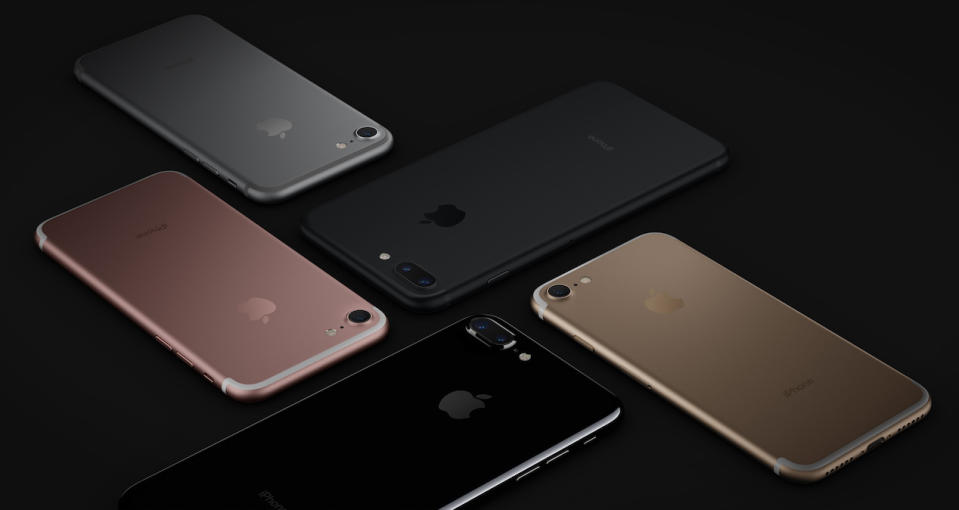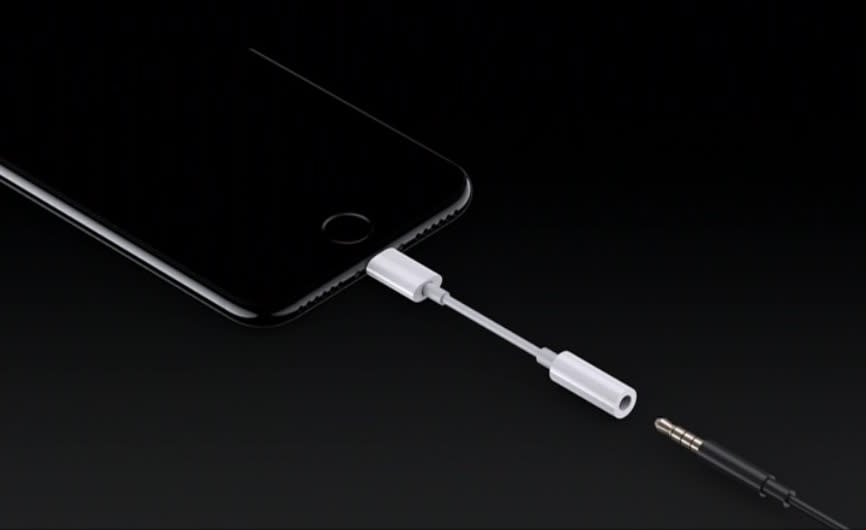Apple announces the water-resistant iPhone 7 and 7 Plus
Surprise!

Apple just introduced the iPhone 7 and 7 Plus, the latest iterations of its premium smartphone. The iPhone 7 and 7 Plus look remarkably similar to the phones they replace -- this is the smallest generational design shift in the iPhone's history -- but that's not to say nothing has changed.
The antenna bands on the back of the previous models have been made more discreet; they now hug the edges of the device. This repositioning has allowed Apple to squeeze in larger camera bumps on the back.
For the first time in the iPhone's history, the new phones are "water and dust resistant," up to IP67 (i.e., splashproof, not submersible). As we expected, there's no headphone port to be seen, but there's at least a stereo speaker for the first time. The home button no longer physically clicks in, but a haptic-feedback mechanism will trick your finger into thinking it has.
Moving on to what you can't see, the new iPhones are powered by Apple's latest in-house SoC, the A10 Fusion. As usual, Apple isn't giving firm figures on performance here. It says it's 64-bit, 4-core chip, with two high-power cores and two low-power cores to save battery life. The iPhone 7 lasts two hours more than the iPhone 6S, while the iPhone 7 Plus lasts one hour more than the iPhone 6S, apparently.
As for the nitty-gritty, Apple's sticking with comparative and superlative statements, like "40 percent faster processing" and "two-thirds the power" graphics performance when compared to the 6S's A9. It's "the most powerful chip ever in a smartphone" and capable of rendering "400 flying monkeys" in Oz: Broken Kingdom. Expect to see companies like Chipworks tearing the A10 down to tell us exactly what's inside once the 7 and 7 Plus are available.
One area that Apple has traditionally excelled in is cameras, but with the Galaxy S7 and Note 7, Samsung basically caught up this year, even besting the 6S and 6S Plus in some areas. To that end, Apple has thrown improved cameras into both its new phones. For both devices, the new FaceTime HD camera ups the resolution from 5 to 7 megapixels. The big-ticket item for the smaller model -- following the addition of 4K video last year -- is a new f/1.8 12-megapixel "low-light loving" camera with optical-image stabilization. There's also a new four-color LED flash, a "flicker-sensor" to avoid flickering lights in videos and RAW DNG capture, plus Apple says shutter lag is down to 25 milliseconds.

Optical-image stabilization has been around in the larger iPhone models since their introduction, so with that ace removed from its sleeve, the 7 Plus is getting a new feature to differentiate itself: a dual-camera system. The new cameras, both at 12 megapixels, operate together in ways we've seen before from other manufacturers. They're set at different focal lengths -- one wide, the other telephoto -- which allows you to "optically zoom" to 2x by switching cameras. You do this by tapping on a button above the on-screen shutter key, and you can also swipe across to zoom digitally up to 10x. We saw a similar trick used to great effect with the LG G5, and with Apple's penchant for high-quality optics and sensors, it's likely to be even better here.
The dual lenses will also allow you to play with depth of field via a software update later this year. When you're taking a photo, you can select a "portrait mode" that, with a bit of (OK, probably a lot of) processing, will allow you to choose different points of focus and add effects like blurry backgrounds. It's not quite a Lytro, but again it's something we've seen work fairly well in past phones (namely HTC's One M8).
So we now have a phone that's storing more image data than every before, along with potentially a short Live Photo video clip: We're talking upward of 6MB of storage taken up every time you press the shutter. To remedy that, Apple has finally dropped its much-maligned 16GB storage option. The lowest storage tier is now 32GB, with the middle- and top-tier options sitting at 128GB and 256GB, respectively. Essentially, it's doubled everything.
Sticking with the forced segues, it would be remiss of Apple to let you look at those photos you've stored on last year's screen, and so it's improving both models' displays. There's no resolution bump -- we're still talking 1,334 x 750 for the 4.7-inch 7 and 1,920 x 1,080 for the 5.5-inch 7 Plus -- but there is an improvement in color gamut. Both phones now support the P3 color space, which debuted on the iMac range before heading to the iPad Pro 9.7.
P3 is a cinematic standard, and it covers a color range 25 percent larger than the sRGB gamut used in the 6S. There's an argument to be made -- and it's been made, believe me -- that Apple should've gone with the widely used Adobe RGB gamut, which is similar in size but covers more green and blue than P3. But Apple is sticking to its guns. As for what all of this means for you, dear reader: You'll see much deeper reds and yellows than you would have previously, which is handy for viewing images with things on the red-and-yellow spectrum (sunsets, fall leaves, white people) in them.
What better way to enjoy your ... okay, I give up on segues. Apple killed the headphone jack. It's betting that the future of headphones is wireless, and that's a fair bet. But the vast majority of headphones in stores (and in homes) are wired. To remedy that, it's packing in Lightning EarPods and this beautiful and elegant Lightning-to-3.5mm adapter in the box:

Apple says it's doing this because it has the "courage to move on, do something new that betters all of us." To be clear, history is very much on Apple's side when it comes to dropping old technology for new. It's axed the VGA port, the floppy drive and the optical drive, all to condemnation from various circles. With those drops, it eventually proved correct, and the chances are that, eventually, it'll prove correct here too.
Whether you agree with the decision or not, it's going to be a painful transition for many. The wireless-headphone market isn't quite there yet, and the Lightning-headphone market barely exists. Apple has the power to boost that market, of course, and it's doing that with new $159 wireless earphones called "AirPods" as well as a ton of new wireless Beats headphones.
So when can you buy one? Pre-orders begin this Friday, and it'll be available on Sept. 16th. The iPhone 7 starts at $649 for the 32GB model while the iPhone 7 Plus starts at $769.
Click here to catch all the latest news from Apple's "See You" event.












